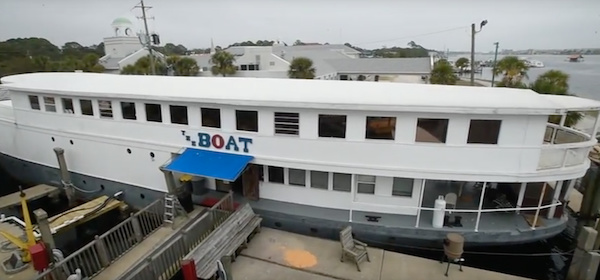Local landmark nearing 100th ‘berthday’
Jim Thompson | 315-4445 | @Jimtnwfdn | jthompson@nwfdailynews.com | Northwest Florida Daily News
FORT WALTON BEACH — Jim Tucker is planning a birthday party — for his one-of-a-kind concrete-hulled boat.
Tuckers’ boat — actually “The Boat,” a longtime local landmark moored just off Miracle Strip Parkway next to St. Simon’s Episcopal Church in Santa Rosa Sound — will be 100 years old on June 15, 2021.
Tucker, 85 years old himself, is humorously optimistic he’ll be around for the party.
“I might make it,” he laughed, sitting in the sprawling apartment office he’s fashioned in the stern of the triple-decked 150-foot vessel.
According to one yellowed page in a sheaf of records and photographs compiled by Tucker, the Army took delivery of the vessel on June 15, 1921. It was commissioned as the Gen. Frederick C. Hodgkins and placed in service as a troop transport in 1922, ferrying men and material along the Cape Fear River in North Carolina from Wilmington to Fort Caswell. The boat was built by the Newport Shipbuilding Company in Wilmington, and would return there twice during its checkered history.
Tucker’s early efforts to establish the history of The Boat were stymied by his assumption it was a Navy ship. He persisted for some time in trying to track the boat’s history through the Navy, until in his words, “They said, 'Idiot, how many times do we have to tell you it’s not a Navy vessel?”
By the late 1920s, according to Tucker’s research and various other historical accounts, the boat was in private hands, ferrying bananas from Venezuela to the United States. Just a few years later, it was moored in Biscayne Bay as a gambling boat. The boat returned to military service in 1941, used by the Coast Guard to house guardsmen being trained in Wilmington for overseas duty in World War II.
Immediately after the war, the boat was used as temporary offices for the U.S. Maritime Commission, a now-defunct federal agency that had been charged with modernizing the nation’s merchant ship fleet.
In 1951, the boat was purchased by Eldridge Fergus, a Wilmington fish merchant who turned it into a floating restaurant. In a couple of eerie reminders of its military origins, the Fergus Ark was hit by a Navy submarine in 1955, and six years later was struck by the USS North Carolina as the battleship was being maneuvered into a nearby mooring.
From there, the boat went to Tampa, where it served as a restaurant under two separate owners until 1974, when Fort Walton Beach developer A.P. Qualls purchased the vessel and moored it near Brooks Bridge as The Showboat.
It was there that the vessel first attracted Tucker’s attention. Over the years, it had developed a crack in its concrete hull, meaning that Qualls had to keep its bilge pumps running constantly. One day, Tucker said, he noticed the bilge pumps weren’t running, so he decided to jump into the water and check the barnacle-encrusted hull.
“The barnacles had sealed the crack!” he laughed.
Qualls had already been trying to sell the boat, and with a swap involving a couple of Tucker’s rental properties, the boat was moved a short distance to its new mooring.
Asked why he bought The Boat, Tucker says it was nothing more than “the novelty of it. It’s just one of a kind. There are other concrete ships, but none of this vintage or type.”
Over the years, The Boat has become home to a collection of artifacts and photographs from Tucker’s life as a 22-year Army veteran, his stint on the local city council and his business ventures. The top deck of the boat, an open area that clearly shows the vessel’s various restaurant incarnations, is jammed with Tucker’s memorabilia.
“I come up here and reminisce a lot,” he said.
At least initially, Tucker’s mooring of the boat next to St. Simon’s on the Sound Episcopal Church created some friction.
“The church fought me tooth and nail,” he said. “They thought I was going to use it for nefarious things.”
He hasn’t, but many passersby are under the impression The Boat is something more than just a boat.
"I’ve had all kinds of people who walk up and say, ‘Is this a bar?’ " he said.
Tucker doesn’t mind the question at all. In fact, he’s obliged some of those visitors by sharing a drink with them.
“I’ve met some great people,” he said.
While concrete-hull boats aren’t common, they are among the easiest vessels to build, they’re durable and they’re easy to maintain, particularly as military vessels.
In fact, Tucker doesn’t worry at all about the hull of The Boat. But its wooden interior, subjected to the dampness of being on the water, is starting to be a concern. He estimates that he’ll spend as much as $30,000 on interior maintenance and repairs in the coming year.
That work will be done, in part, as Tucker considers the fate of The Boat after he is gone. Plans are in place to transfer the boat to his daughter, Charlotte, who lives in Mississippi.
“I don’t want it to be a white elephant for her,” he said.

